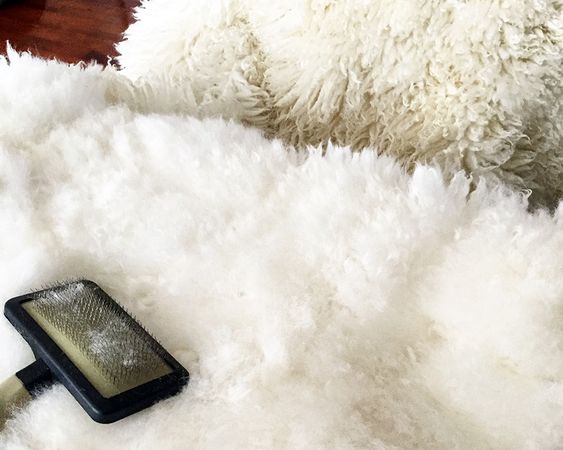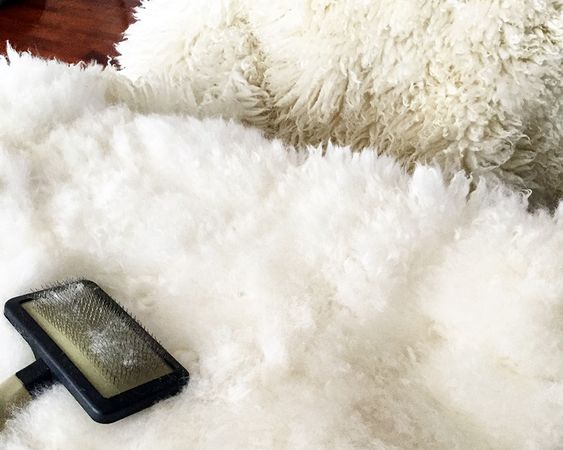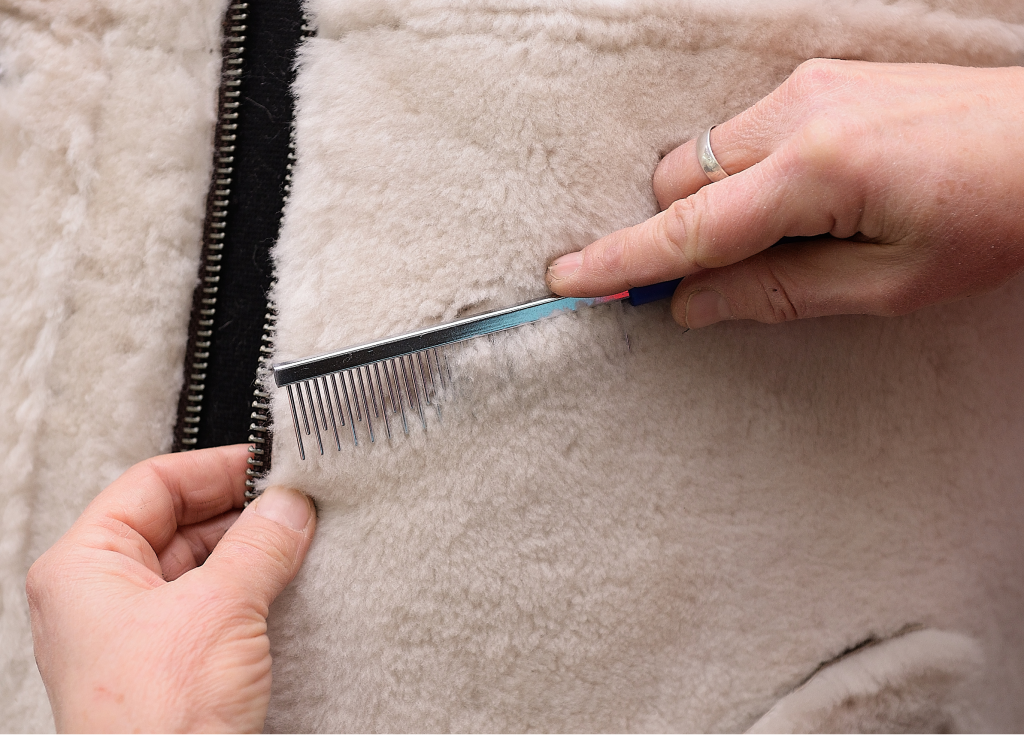
Sheepskin Care: Tips for Cleaning and Maintenance
Share
 Natana Nikola
Natana Nikola

Why Sheepskin Requires Special Care
Sheepskin is more than a mere material; it's a testament to nature's ability to create something wonderful and functional. This natural fabric is known for its softness, insulation properties, and ability to wick moisture away from the skin. It is a favored choice for many products, from luxurious coats and cozy slippers to elegant home decor and therapeutic medical aids. However, the very characteristics that make sheepskin so valuable also make it uniquely susceptible to damage if not cared for properly.
One of the standout properties of sheepskin is its natural lanolin content, which contributes to its softness and moisture-resistant qualities. Lanolin helps sheepskin self-clean to some extent, but it also means that harsh detergents can strip away these natural oils, leaving the material dry, stiff, and less comfortable. Additionally, sheepskin's dense wool fibers can trap dirt, dust, and oils, which can degrade the material if not carefully removed.
Sheepskin's ability to maintain a comfortable body temperature in cold and warm environments is another reason it requires special attention. Excessive heat or direct sunlight can damage the fibers and fade the color. At the same time, improper drying techniques can cause the leather side to become stiff and brittle, losing its natural flexibility.
Proper care for sheepskin involves gentle cleaning methods that preserve its lanolin, careful drying to maintain its shape and texture, and specific storage conditions to prevent damage. When maintained with the proper techniques, sheepskin products can last for many years, becoming even more beautiful with age. Regular, mindful care enhances the longevity of sheepskin items and ensures that they continue to provide unparalleled comfort and elegance. This commitment to preservation allows sheepskin owners to enjoy the full range of benefits offered by this remarkable material, making every effort towards its care a worthy investment.

Daily Care Tips
Maintaining your sheepskin products' pristine condition and luxurious feel doesn't require elaborate efforts; simple, daily actions make all the difference. By incorporating a few easy maintenance tips into your routine, you can prevent dirt buildup, preserve the material's plushness, and ensure your sheepskin remains as inviting and comfortable as ever. Here are some essential daily care tips to help keep your sheepskin looking its best:
Shake and Fluff Regularly
Giving it a gentle shake helps remove dust and loose dirt that can accumulate within the fibers. Fluffing up the material rejuvenates its texture and prevents the wool from becoming matted, ensuring it retains its natural, fluffy appearance.
Immediate Spot Cleaning
Address spills and stains immediately with a damp cloth, dabbing gently rather than rubbing. This quick response can prevent substances from setting into the fibers, making them easier to remove without requiring intensive cleaning that could harm the sheepskin.
Avoid Direct Sunlight
While it might be tempting to air out sheepskin items in the sunshine, prolonged exposure to direct sunlight can fade the color and damage the fibers. Instead, choose a shaded, well-ventilated area to air out sheepskin products.
Regular Brushing
Use a soft-bristled brush designed for sheepskin to comb through the fibers gently. It not only removes tangles and keeps the wool looking smooth but also helps to distribute natural oils throughout the material, enhancing its inherent luster and softness.
Protect from High Traffic
Consider rotating or repositioning sheepskin items in areas of high traffic or frequent use to ensure even wear. It is particularly relevant for rugs, cushions, and other home decor items, helping them maintain an even appearance and texture over time.
Minimize Moisture Exposure
While sheepskin is naturally moisture-wicking, it is best to minimize its exposure to wet conditions. If your sheepskin does get wet, allow it to air dry naturally away from direct heat sources. It preserves the integrity of the leather backing and prevents the wool from becoming stiff or misshapen.
By adopting these daily care practices, you extend the life of your sheepskin products and enhance their beauty and functionality. These simple actions can significantly impact the longevity and enjoyment of your sheepskin, making them invaluable habits for any sheepskin owner.

Cleaning Sheepskin: Dos and Don'ts
Proper cleaning is crucial to maintaining the beauty and longevity of sheepskin products. Whether dealing with a minor spill or it's time for a more thorough cleaning, knowing the dos and don'ts will ensure your sheepskin remains luxurious and intact. Here's a guide to help you navigate the cleaning process effectively.
Dos
- Spot Cleaning for Minor Spills. Use a damp cloth and mild sheepskin detergent to blot the affected area gently for small spills or stains. Avoid rubbing the stain, which can push it deeper into the fibers.
- Use a Sheepskin-Specific Detergent. Always opt for a detergent specifically designed for sheepskin when a more thorough wash is necessary. These detergents are formulated to maintain the natural oils in the wool and prevent damage to the fibers.
- Hand Washing. Hand washing is often the safest cleaning method if the item is small enough. Fill a basin with lukewarm water and a small amount of sheepskin detergent, then gently agitate the water with your hands before submerging the item. Rinse thoroughly with clean, lukewarm water to remove all soap residue.
- Machine Washing (If Applicable). Some sheepskin items can be washed gently with cold water using a sheepskin-approved detergent. Always check the care label first to ensure machine washing is safe for your item.
- Air Dry Naturally. After washing, gently squeeze out excess water without wringing, and lay the item flat to dry in a shaded, well-ventilated area. Avoid direct heat sources or sunlight, which can damage the wool and leather.
- Brush While Damp. To maintain the fluffy texture, lightly brush the wool with a sheepskin brush while it's still damp. It helps detangle the fibers and restore their natural loft.
Dont's
- Avoid Harsh Chemicals. Never use bleach or fabric softeners on sheepskin; these can strip the natural oils and damage the fibers.
- Don't Soak or Use Excessive Water. Soaking can cause the leather to warp and the wool to mat. Use just enough water to clean the surface without saturating the sheepskin.
- Never Tumble Dry or Use Direct Heat. High temperatures can shrink and harden the leather backing, ruining the texture of the wool.
- Avoid Aggressive Rubbing. Whether you're spot cleaning or washing, always treat sheepskin gently to prevent damage to the fibers.
Professional Cleaning
Consider professional cleaning for items too large to clean at home or require special care. Professional cleaners specializing in leather and sheepskin have the expertise and equipment to clean and condition sheepskin products without causing damage.
Following these guidelines, you can keep your sheepskin looking and feeling luxurious for years. Regular, careful cleaning not only preserves the unique qualities of sheepskin but also ensures that your items remain a cherished part of your home or wardrobe.
Drying and Brushing Techniques
After cleaning your sheepskin, proper drying and brushing are crucial to ensure it retains its natural shape, texture, and plushness. Here are the best practices to follow.
Drying Sheepskin
- Gently Remove Excess Water. Carefully press out any excess water after washing. Avoid wringing or twisting the sheepskin, which can distort the fibers and backing.
- Lay Flat to Dry. Place the sheepskin on a clean, dry towel away from direct heat and sunlight. Direct exposure can cause shrinking and fading. Dry it in a well-ventilated area to speed up the drying process without damaging the material.
- Reshape While Damp. Gently stretch and reshape the sheepskin while damp. It helps maintain its original shape and prevents the leather backing from stiffening.
- Air Dry Completely. Allow the sheepskin to dry completely before use. It may take several days, depending on the thickness of the wool and the humidity in the air.
Brushing Techniques
- Use a Wire Sheepskin Brush. Once the sheepskin is dry, gently brush the wool with a wire sheepskin brush. This type of brush is specifically designed to detangle the fibers without pulling them out.
- Brush in the Direction of the Fibers. Start at one end and gently brush in the direction of the wool's natural lay. It restores the fluffiness and natural look of the fibers.
- Regular Brushing. Even when not cleaning the sheepskin, regular brushing can help maintain its appearance, preventing matting and keeping the wool soft and fluffy.
Stain Removal Guide
Dealing with stains promptly can prevent permanent damage. Here are tips for removing common types of stains from sheepskin.
- Oil Stains. Blot the excess oil with a clean, dry cloth. Sprinkle talcum powder or cornstarch on the stain and let it sit for several hours or overnight. The powder absorbs the oil, making it easier to brush away gently.
- Ink Stains. Use a cotton swab dipped in isopropyl alcohol to dab gently at the stain. Do not rub, as this can spread the ink. Repeat if necessary, then clean the area as per the cleaning instructions.
- Wine Stains. Blot up as much of the spill as possible. Mix a solution of lukewarm water and sheepskin detergent, and gently dab the stain. Rinse by wiping with a cloth dipped in clean water. Avoid soaking the area.
Storage Solutions for Sheepskin Products
Proper storage is essential to keep sheepskin products pristine, especially during off-season periods.
- Clean Before Storing. Ensure the sheepskin is clean and completely dry before storing. It prevents mold, mildew, and insect damage.
- Avoid Plastic Bags. Store sheepskin in breathable fabric bags or acid-free tissue paper to allow air circulation and avoid moisture buildup.
- Keep Away from Direct Light and Heat. Store in a cool, dark place to prevent fading and drying out the leather.
- Maintain Shape. Roll out more significant items like rugs instead of folding them to prevent creases and maintain their shape.
Adhering to these drying, brushing, stain removal, and storage guidelines ensures that your sheepskin products remain luxurious, soft, and durable for many years.
Conclusion
Caring for sheepskin products requires attention to detail and understanding the material's unique properties. From daily maintenance like shaking and brushing to keep the fibers fluffy and prevent dirt buildup to specific cleaning dos and don'ts that ensure the sheepskin's natural oils and texture are preserved, each step is crucial for maintaining the beauty and longevity of your items. Proper drying and brushing techniques post-wash help retain the shape and softness, while targeted advice for stain removal ensures that accidents don't lead to permanent damage. Moreover, storing your sheepskin products correctly during off-season periods will protect them from harm and keep them looking pristine for years to come.
We encourage you to follow these essential care tips to ensure your sheepskin remains a luxurious and durable addition. Treating your sheepskin with the care and respect it deserves will allow you to continue to enjoy its unparalleled comfort and elegance for many years.
For those who cherish sheepskin's natural beauty and timeless appeal, we invite you to explore MerinoMood's extensive collection. With an unwavering commitment to quality, our range of sheepskin outerwear, accessories, home decor, and medical-grade products offers something for everyone. Visit MerinoMood to discover pieces that blend style, comfort, and durability, embodying the essence of luxury sheepskin care. Let MerinoMood enhance your world with products that bring warmth, beauty, and longevity into your home and wardrobe.

FAQ
1. Can I iron sheepskin to remove wrinkles?Avoid using an iron directly on sheepskin, as high heat can damage the fibers and leather. If you must address wrinkles, use a steamer on the wool side at a safe distance, keeping the heat indirect. Always test a small, inconspicuous area first.
2. Is using a vacuum cleaner on my sheepskin rug safe?
Yes, but with caution. Use a vacuum cleaner with a gentle brush attachment to avoid pulling on the fibers. Vacuum lightly in the direction of the wool to remove dust and debris without damaging the rug.
3. How do I protect my sheepskin from moths and other pests?
Store sheepskin in a breathable fabric bag with natural moth repellents like lavender sachets or cedar blocks. Avoid chemical mothballs, as their odor can permeate and damage the wool.
4. Can sheepskin be exposed to rain or snow?
While sheepskin is naturally water-resistant due to its lanolin content, prolonged exposure to wet conditions is not advisable. If your sheepskin gets wet, shake off the excess water and dry naturally away from direct heat. Once dry, brush the wool to restore its texture.
5. How often should I clean my sheepskin product?
The frequency of cleaning depends on usage and exposure to dirt. Generally, thorough cleaning once or twice a year is sufficient for items like rugs and throws, while wearable items may require more frequent care depending on wear.
6. What should I do if the sheepskin starts to smell?
Airing the sheepskin in a shaded, well-ventilated area can often eliminate odors. If the odor persists, a light cleaning with a sheepskin-approved detergent and thorough drying should help. For persistent or strong odors, consider professional cleaning.
7. Can I dye my sheepskin to change its color?
Dyeing sheepskin is not recommended as a DIY project since it requires specific dyes and techniques to avoid damaging the fibers and leather. If you desire a different color, it's best to purchase sheepskin in the color you want or consult with a professional who specializes in dyeing leather goods.
8. How do I maintain the softness of sheepskin shoes or slippers?
To keep sheepskin footwear soft, use a soft-bristled brush to gently brush the wool regularly. A specialized sheepskin conditioner can rejuvenate the fibers if the interior becomes less smooth. Always ensure the shoes or slippers are clean and dry before applying any products.
